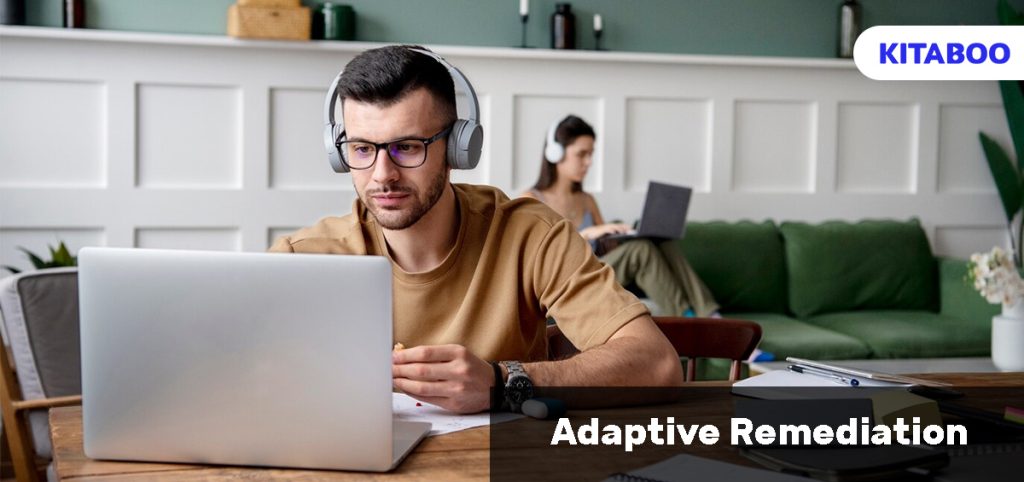
Personalized Learning Made Easy with Adaptive Remediation
Summarize this blog with your favorite AI:
In today’s educational landscape, the concept of personalization is not just a trend but a fundamental shift in how we approach learning.
As digital platforms and eLearning solutions become increasingly prevalent, the ability to offer tailored, individualized educational experiences has transformed from a luxury to a necessity. Consequently, more than ever, educators are recognizing the immense value of offering instruction that aligns with each student’s unique needs and pace.
Digital textbook platforms like KITABOO amplify this shift, harnessing technology’s potential to provide a richer, more customized learning journey. They not only help you create and publish interactive digital content but also empower educators to track student engagement, adapt resources in real time, and provide feedback efficiently.
Read on to explore how adaptive remediation is shaping the future of education, acting as a catalyst in the quest for true personalization.
Table of Contents
I. What is Adaptive Remediation?
II. How Can Personalized Learning Be Simplified Using Adaptive Remediation?
III. How Does Personalized Learning Help Improve Student Engagement?
IV. Wrapping Up
What is Adaptive Remediation?
Adaptive remediation offers a tailored instructional method, adjusting support to each learner’s unique requirements. By their very nature, remedial programs are targeted towards raising a student’s basic skill level and abilities to the level that is expected of their age.
Remedial instruction, therefore, focuses on helping students meet these standards by offering instruction that is precisely calibrated to their current abilities and knowledge. This allows for a more nuanced and personalized teaching strategy, addressing individual gaps and challenges head-on.
How Can Personalized Learning Be Simplified Using Adaptive Remediation?
Learning personalization helps students adjust a curriculum to suit their learning needs – and it is here that adaptive learning does its part with data and analytics. With that said, it is important to differentiate between these commonly used terms before understanding how adaptive remediation plays a part in this ecosystem.
Learning personalization refers to pacing a course or learning according to your needs. On the other hand, adaptive learning is the process of collecting students’ learning data to craft learning experiences that are reflective of their progress and comprehension levels. Adaptive remediation leverages technologies like AI and ML to provide personalized remedial instruction to students.
Adaptive remediation can encompass:
- Remedial sessions
- Case studies
- Pre-session preparations
- Revisiting past concepts
- Introductory materials.
It not only addresses gaps in a student’s understanding but also anticipates learning challenges, offering timely support.
How Does Personalized Learning Help Improve Student Engagement?
Adaptive remediation is an excellent way to improve the academic readiness of students. It helps them gain mastery over (or control) the areas that they struggle with. It also empowers the students to improve their learning outcomes drastically.
The implementation of adaptive remediation is primarily targeted towards reducing cognition gaps between the students of a classroom. It, therefore, necessitates for the student data to be used for creating an impact on their learning journey rather than just for evaluation and feedback.
Below are some ways personalized learning, powered by adaptive remediation, boosts student engagement:
1. Identification of Cognitive Gaps
Adaptive remediation, with its focus on student cognition, serves as an invaluable tool for pinpointing learning gaps. When integrated with user-friendly technologies accessible from home, AI-driven systems can continually assess individual student needs every time they engage with the learning platform.
Educators, armed with these insights, can tailor the curriculum to align with the needs of students actively using adaptive remediation tools. Such fine-tuned personalization may be subtle, yet it offers students flexibility, paving the way for enhanced learning outcomes.
2. Implementation of the TaRL Approach
Adaptive remediation starts with a foundational skill essential for all students in a classroom and progressively assists them in mastering it over time. TaRL, or Teaching at the Right Level, is an educational approach that complements this. It takes into consideration the current abilities and skills of all the students in the classroom.
The best part is that with automated and digitally deployed adaptive remediation programs, teachers don’t have to get involved in the initial assessment process. They merely need to supervise and direct the program, enabling the AI engines to curate learning journeys that teach each student individually at their level.
3. Improved Student Modeling
AI-based programs model each student’s learning process and recommend to the teachers the best ways to enhance their performance and outcomes.
The AI models are based on cognitive processes, periodic assessments, quizzes, activities, and a variety of other inputs that students provide on the educational platform. The data gathered in this manner is pivotal to designing effectively personalized lessons for the students of a classroom.
Using AI models of students to enhance education is particularly beneficial for educational institutions facing high dropout rates.
4. Implementation of Refined Pedagogical Strategies
Adaptive remediation can be a beneficial approach for lesson personalization for educators who deal with students who have significant curricular knowledge gaps.
Prompt feedback and targeted interventions enable educators to fine-tune their teaching methodologies, providing students who face challenges with a clear path to betterment.
By harnessing adaptive remediation, educators can transition from viewing students through labels like “struggling” or “lagging” to recognizing them as “progressing” or “evolving.” This shift reshapes educators’ perspectives, viewing each student as a unique learner with distinct needs. Such an approach ensures a tailored learning experience perfectly aligned with a student’s individual requirements.
Wrapping Up
Equitable learning can be made possible using adaptive remediation, and with help from advanced digital technologies, the entire ecosystem can be drastically simplified.
Especially in the case of learning personalization, adaptive remediation helps educators see the learning needs of the students side by side with their learning preferences.
In this regard, digital textbook platforms like KITABOO come in handy. It not only helps you create and publish mobile-friendly digital content but also integrates adaptive learning features, ensuring content is accessible and tailored to each student’s specific needs.
Connect with our experts for further details!
Write to us at contact@kitaboo.com to discover how we can revolutionize your educational approach.
Suggested Reads:
Discover how a mobile-first training platform can help your organization.
KITABOO is a cloud-based platform to create, deliver & track mobile-first interactive training content.



